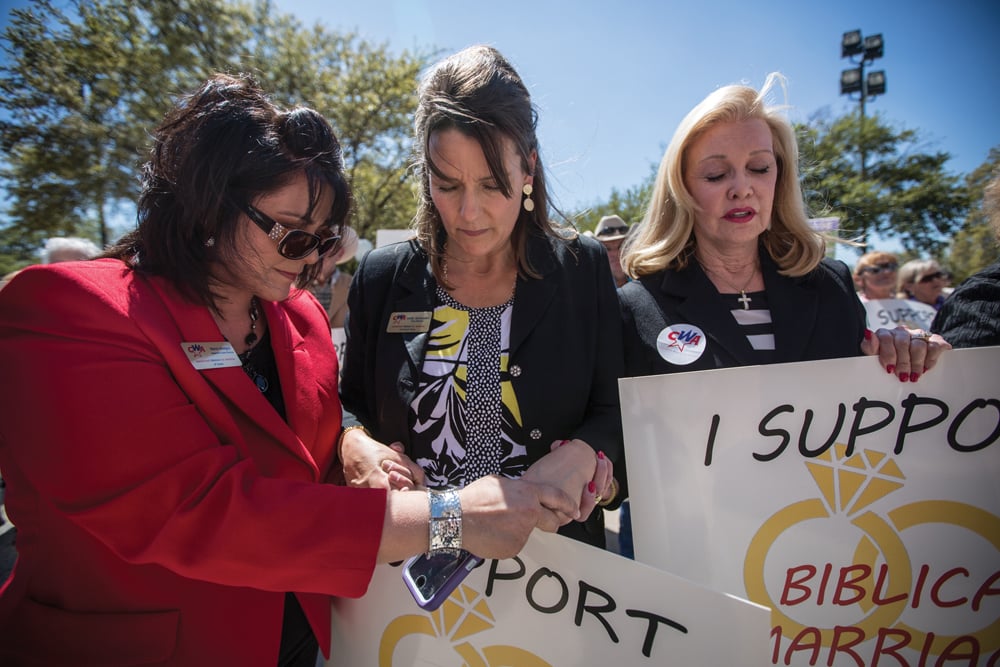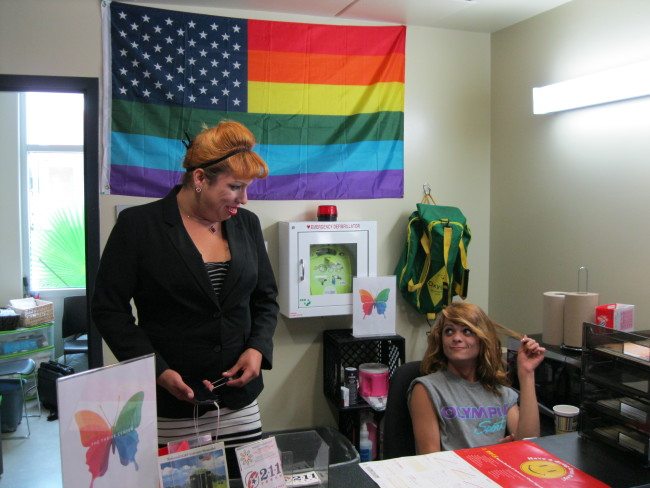
LGBT Advocates Laud Passage of Homeless Youth Study
Above: Thrive Youth Center residents Chanel Versace, left, and Damien Pena, who both identify as transgender, talk behind the front desk in San Antonio last month.
When Chanel Versace’s father discovered she was gay at 17, he threatened to kill her.
“He said, ‘I’m not going to have a faggot as a son. If that’s the case, I’ll kill your ass and then I’ll kill myself,'” Versace recalls. “So I’m like, ‘If that’s the case, I’ll just run away.'”
Versace, a California native who now identifies as transgender, ended up in San Antonio, where she lived on the streets for four years.
Versace would occasionally stay at the city’s Haven for Hope homeless shelter, but because of threats and harassment from other residents over her transgender status, she felt safer under a bridge.
In February, Versace became one of the first residents at Thrive Youth Center, the only homeless shelter in Texas specifically for LGBT people.
Thrive Youth Center occupies its own wing on the bottom floor of an office building at Haven for Hope, and unlike the main shelter, it includes private rooms and a bathroom with stalls and shower curtains.
Now 23, Chanel is finishing her GED and plans to become a certified nursing assistant. Since moving to Thrive, she’s also legally changed her name and gender marker, important steps toward finding employment.
Sandra Whitley, executive director of Thrive Youth Center, said Versace’s story is typical of many youth she encounters.
Studies suggest up to 40 percent of the nation’s 1.6 million homeless youth identify as LGBT.
Studies suggest up to 40 percent of the nation’s 1.6 million homeless youth identify as LGBT, with most having been kicked out or run away due to parental rejection. Whitley said she believes the figure is more like 50 percent in San Antonio and other parts of the South, but no study has ever examined how many homeless youth in Texas are LGBT.
Whitley and other advocates are hoping that will soon change, thanks to a proposal from Rep. Sylvester Turner (D-Houston) that is on its way to the governor’s desk after clearing the House and Senate. Under House Bill 679, the state would conduct a study of homeless youth, including collecting data, examining needs, identifying funding sources and developing a strategic plan.
Turner said the study would take a “holistic” look at homeless youth, including who they are and why they’re on the street. He said homeless youth are more susceptible to sex trafficking than any other group.
“There are schools within my district that have washers and dryers at the schools because there are kids who are homeless and don’t have a place to wash their clothes,” Turner said. “There is a need out there, but the depth of that need and whether or not we have adequate services to respond appropriately, we don’t really know. ”
Turner also stressed that the bill applies to all homeless youth, not just those who are LGBT.
“It doesn’t matter whether a child is black or white, Jew or gentile,” he said. “The reality is, these are our children, and I think we have a responsibility to create an environment and a society that gives all of our children an opportunity to succeed and live and prosper.”
Daniel Williams, legislative specialist for Equality Texas, said although the bill doesn’t specifically mention it, he’s confident the study would include information about whether homeless youth are LGBT. Either way, Equality Texas backs the measure and considers it one of the few pro-LGBT bills to ever pass the Legislature.
“Anything that can be done to better serve homeless youth is an LGBT issue,” Williams said.
While there is no data on LGBT homeless youth in Texas, Thrive Youth Center is amassing anecdotal evidence. The shelter—which has five rooms with two beds each for people 25 and up, along with a large dorm room with eight bunk beds for those ages 18 to 24—has been at capacity with a waiting list since opening. Whitley said she hopes to eventually serve those under 18, too.
“LGBT young adults face the same discrimination in regular shelters that they do in school or with their families,” Whitley said, adding that most Thrive residents thus far have been transgender. “To them, it was the biggest thing that they had privacy while taking a shower.”
After selling her business and devoting her life to helping LGBT youth a few years ago, the 53-year-old Whitley quickly zeroed in on the “epidemic” of homelessness. She recalled that when she came out as lesbian in 1975 in the Texas Panhandle, her parents put her in an institution.
“I think society as a whole has gotten better, because there’s gay marriage in many states, it’s about to be in every state,” Whitley said. “But I think because it’s gotten better in society as a whole, kids are coming out at an earlier age, and their parents for religious reasons or whatever reasons are kicking their kids out of their house.”
Whitley said most residents have been on the streets since they were 13 or 14. But thanks to Thrive, they finally have a safe haven.
